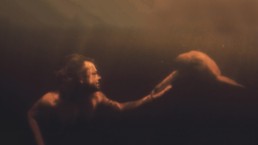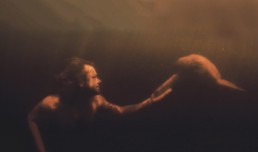‘A River Below’ Review: Exposing the Uncertain Fate of the Amazon’s Pink River Dolphin
This eco-thriller will encourage activism.
In the documentary A River Below, director Mark Grieco captures two very different, contrasting angles on wildlife conservation in the Amazon, highlighting the work of two tenacious environmental activists.
With a provocative style, Grieco illustrates how media coverage had been manipulated to exploit the harmful actions of many South American fishermen along the Amazon River and how environmental activism can lead to unanticipated consequences. While introducing the audience to the captivating landscapes and wildlife of the Amazon, Grieco explores important aspects of the multi-billion dollar fishing industry paid for with the blood of the pink river dolphins.
The film opens with a memorable clip of fishermen working in the darkness and secrecy of night while harpooning one of South America’s most iconic animals, the pink river dolphin, locally known as “Boto.” The brutally shocking encounter is followed by breathtaking aerial footage of the vast Amazon basin accompanied by a tranquil score. The bird’s eye view then dives down into the murky waters of the winding river to discover the curious and charismatic dolphins. This contrasting cinematic sequence leaves you with
goosebumps.
Next, we are introduced to Fernando Trujillo, the world’s leading scientist on the pink river dolphin. He originally came to the Amazon to research the varied wildlife, but quickly fell in love with the dolphins and connected with them on a much deeper level than science could ever evoke. In one of the most biodiverse regions in the world, we learn that these animals are tragically on the brink of extinction. Fernando recounts that when he began his research over 30 years ago, he would see dolphins every day. Now, he often searches over multiple days without seeing any of these sacred animals. In addition to Trujillo, we are also introduced to Richard Rasmussen, a Brazilian TV sensation and environmental activist. He embodies a similar persona and contagious enthusiasm to the late Crocodile Hunter, Steve Irwin, and uses the power of television to share the excitement of his enticing and dangerous wildlife encounters. Rasmussen shares fascinating footage of his underwater experiences with the dolphins and we see how he used his celebrity status to gain an insider’s view of how and why thousands of dolphins are being slaughtered each year.
Grieco’s innovative filmmaking style exposes this hidden truth of the Amazon, highlighting the plight of the pink river dolphin and encouraging activism on their behalf.
Both of these activists understand the complexities of the problem being portrayed in this film– that thousands of sacred botos are being illegally slaughtered to be used as bait to help catch the more lucrative Piracatinga fish. Furthermore, given the vastness of the Amazon basin, it is nearly impossible to follow the blood trail back to the many fishermen responsible for this violation. These activists find that their best strategy to spread awareness of this catastrophe and promote change is by using the power of images and the media to inform and influence public opinion. However, they soon learn their actions threaten the livelihood of many Amazonian communities, and this puts their own safety in jeopardy. Jone Cesar Silva, the Director of AMPA in Brazil, stated that “for 15 years, we wrote about dolphin killings in the newspapers, and we published scientific papers. But nobody believed us. The public and newspapers don’t care about scientific papers. What we needed were pictures and images for TV.” Once the public saw these ghastly images, they created a commotion, leaving the government no choice but to finally get involved.
Grieco’s innovative filmmaking style exposes this hidden truth of the Amazon, highlighting the plight of the pink river dolphin and encouraging activism on their behalf. He captures both the positive and negative ways modern media can shed light on an issue. He also identifies that the problem is much greater than simply the killing of these dolphins and reflects on deeper issues within the infrastructure of many Amazonian communities that rely indirectly on the dolphin for their main source of income. His film creatively gives us a better understanding of the complex cultural, environmental, and economic issues that must be considered in order to find a solution to this problem.
As we watch this important story unfold, despite some government efforts to address the situation, the problem is ongoing and the slaughter of the pink river dolphins continues. A comprehensive solution is needed, yet not obvious. A River Below highlights a number of different and valid perspectives and makes an important contribution to the discussion of how to find the best solution. Interestingly, Grieco’s work is applicable to many other complex environmental challenges faced around the world and highlights the need to consider all perspectives and work together when seeking solutions.
‘A River Below’ is not rated. 86 minutes. Opening this Friday at Laemmle Monica Film Center.
Ellie Vargas
Ellie is a junior at Chapman University, majoring in Creative Producing. Apart from being involved in different clubs and sports on campus, Ellie enjoys working creatively on student films and documentaries!


